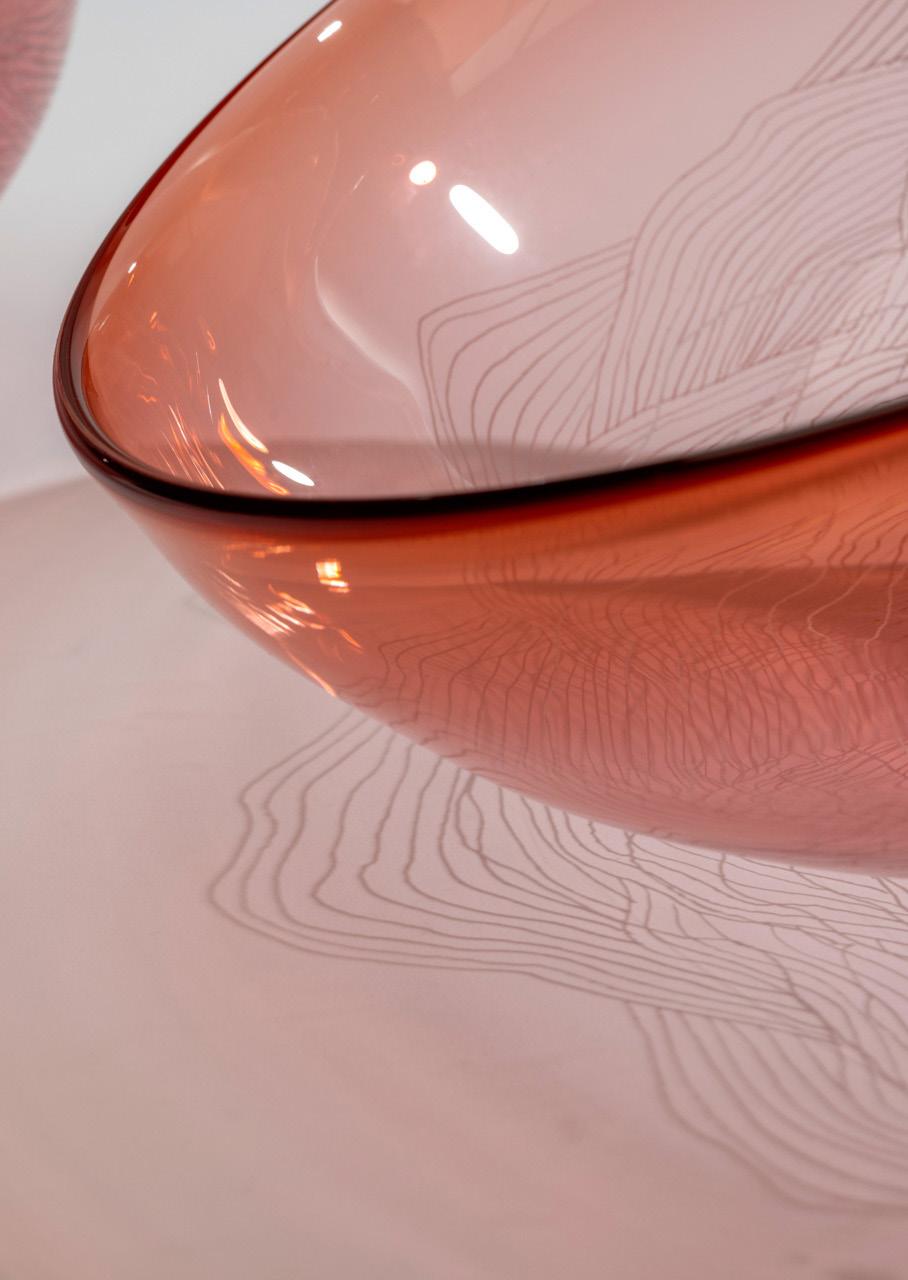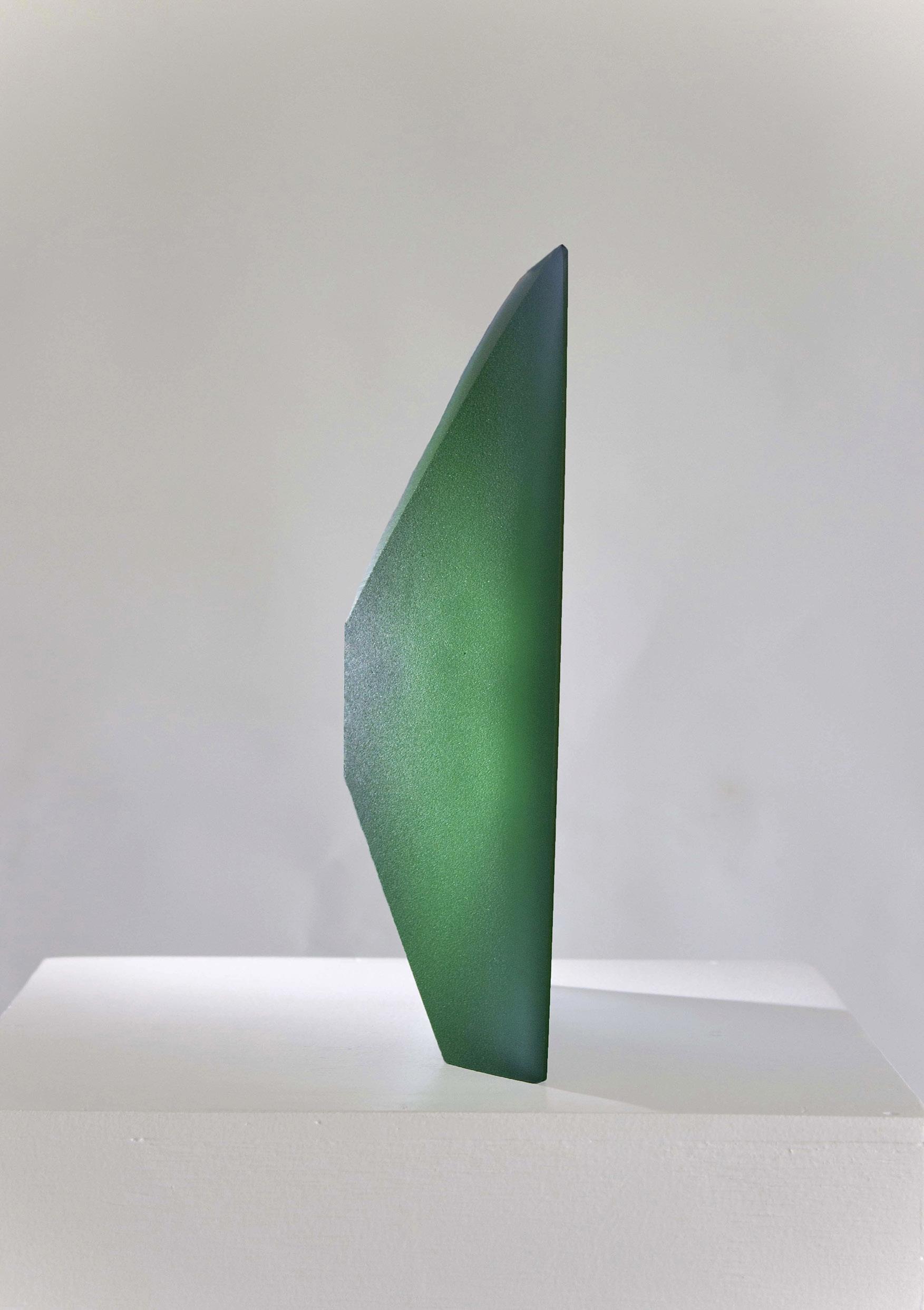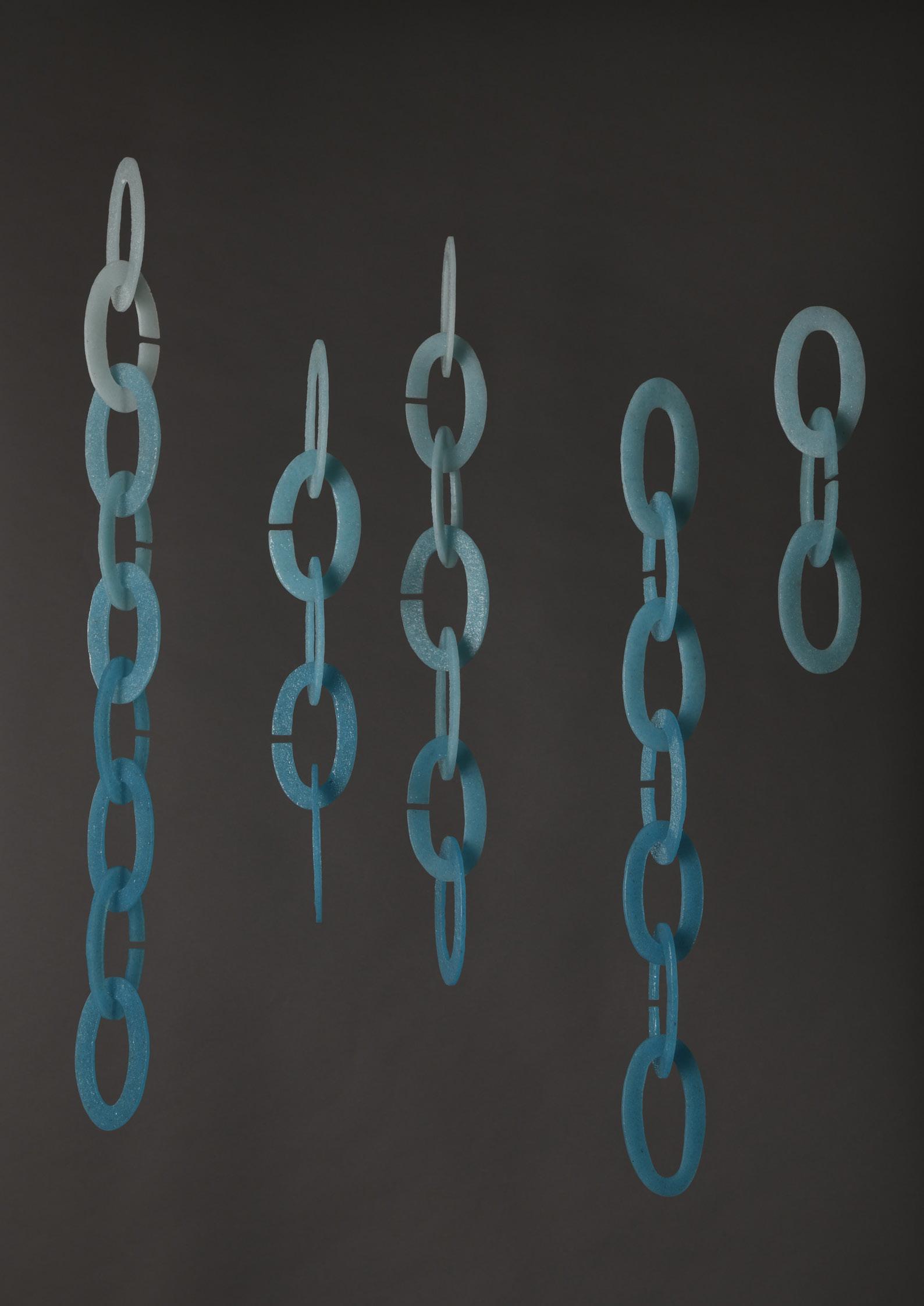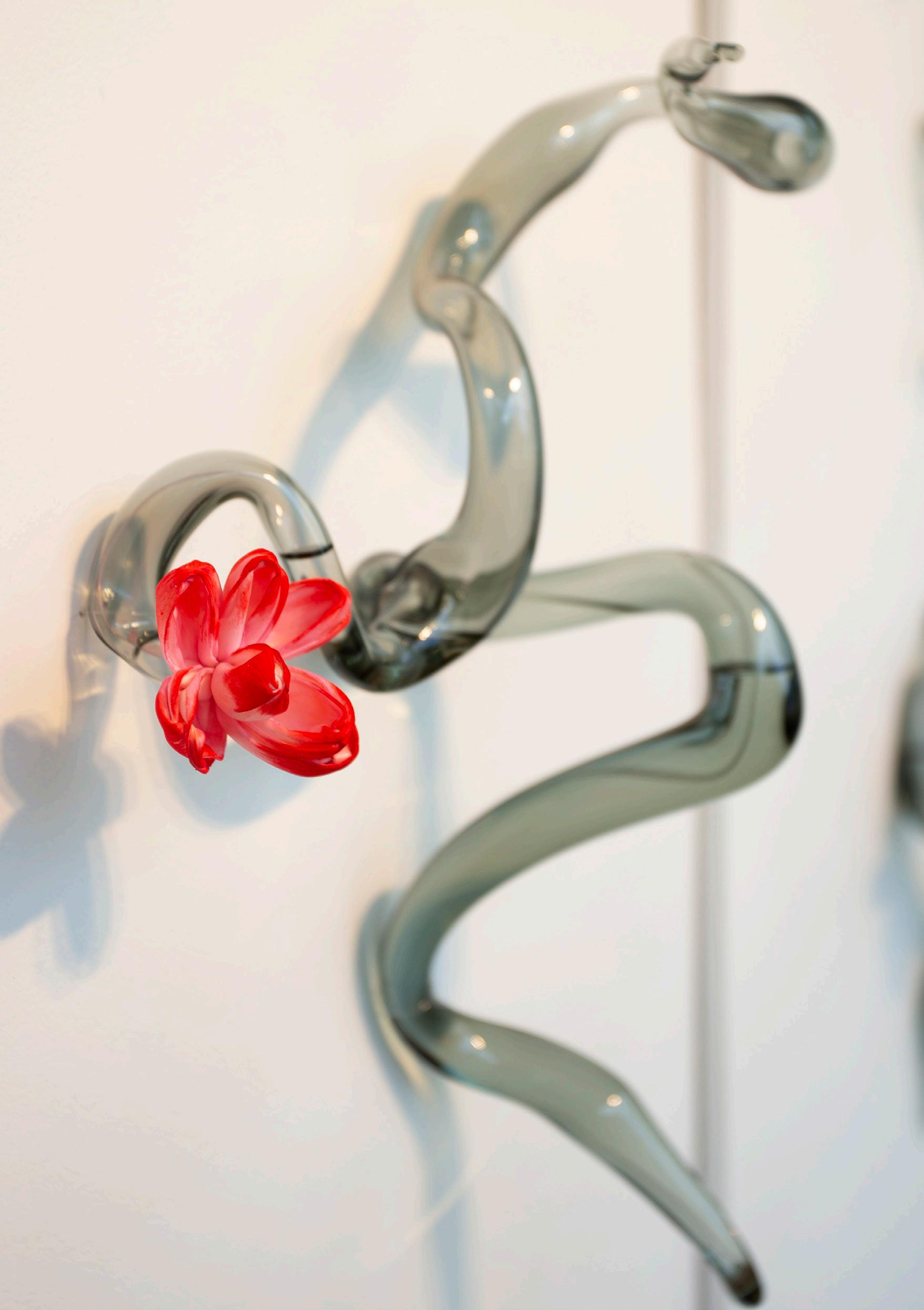Gallery





 Shirley Wu Meditation Forms, 202, installation view. Photo: Wagga Wagga Art Gallery
Shirley Wu Meditation Forms, 202, installation view. Photo: Wagga Wagga Art Gallery
Wagga Wagga Art Gallery through its National Art Glass Gallery has supported the development, scholarship and exhibition of Australian studio art glass for over 40 years. Across this period the Gallery has promoted innovation and excellence in contemporary glass and provided an important launch platform for the careers of many artists. We continue this support with Glass Chrysalis – Glass Art of Promise.
Jointly curated by the Wagga Wagga Art Gallery, Canberra Glassworks, and JamFactory, Glass Chrysalis – Glass Art of Promise is the first of an anticipated triennial event in celebration of new and emerging talent.
Herein, are select new works by eleven of Australia’s premier early career studio glass artists. Produced within the last two years, these glass works showcase developing trends in the contemporary art glass scene alongside individual creativity, innovation, experimentation, while exhibiting a mastery of skill and technique.
The artists represented in Glass Chrysalis have developed their practice, and been mentored in art schools, glass workshops and hotshops across Australia. Such is the breadth and dynamism of this new work that it confirms this new generation of glass makers as artists of exceptional promise.
Dr Lee Anne-Hall Wagga Wagga Art Gallery
 Glass Chrysalis, 2022, installation view. Image courtesy Wagga Wagga Art Gallery.
Glass Chrysalis, 2022, installation view. Image courtesy Wagga Wagga Art Gallery.


The word ‘Chrysalis’ suggests just how precarious it is to make art with glass: the fragility of the materials, the difficulty of the processes, the high stakes in moulding this capricious dangerous substance to artistic concepts. Glass Chrysalis: Glass Art of Promise, now at the National Glass Art Gallery at Wagga Wagga Art Gallery, on Wiradjuri country, is an exemplary commitment to developing and supporting new talent in this field. Australian artists working in glass are a distinguished and diverse bunch, internationally renowned. It’s a very strong field. But how to sustain this energy, this achievement of mature and sophisticated practices, into the future? In a country where resources are thin, funding sources can be uncertain, and, above all, where the processes of making work in glass demand every sort of critical mass: of equipment, in facilities, in cooperation, in critique.
This focus and critical mass has been admirably supported in Canberra, Adelaide, and Wagga Wagga, in particular ways, over the past 50 years, with great success. Now organisations based in the three cities have joined forces to mount Glass Chrysalis, a triennial commitment to profiling early career artists working with glass in a curated exhibition. Under the leadership of Director Lee-Anne Hall at Wagga Wagga, this project has been developed out of the previous biennial National Emerging Art Glass Prize, originally the National Student Art Glass Prize, which had been mounted by the National Glass Art Gallery since 2010.
It is important to emphasise that Glass Chrysalis is a selected exhibition, not a prize: the new model gives professional development support to each participating artist, rather than one winner taking all. The three organisations and their staff—this time Caitlin Eyre at Adelaide’s JamFactory, Aimee Frodsham at Canberra Glassworks
and National Glass Art Gallery curator Michael Scarrone—have collaborated to select eleven exceptionally promising artists, who were then invited to submit between one and three works of their choice. This means that Glass Chrysalis is committed to sustaining and developing the field as a whole, rather than rewarding the achievement of a single artist.
Even though these artists are classed as ‘early career’, they are already highly developed and formidably skilled: the project aims to include artists with around five
to seven years of experience since graduation. This high level of development is born out in the remarkable technical expertise of the works, but what matters most, given that level of excellence, is the strength of artistic conception, and that is where certain artists shone. ‘Emerging’ means exactly that: coming out of the chrysalis, becoming fully formed. And I would say that Glass Chrysalis: Glass Art of Promise is the more fascinating, not less, for revealing that this process is in train: some artists are still grappling with the challenges of recognising their strengths, or with resolving the presentation of the works.
Let me first consider the outstanding achievements of works that suggest the broad parameters of this energetic field. Jessica Murtagh, trained and based in Adelaide on Kaurna Country, contributed one exceptional vessel that speaks to confidence in her practice. Modern Relic: The good wife and the mental load (2022) is a blown, sandblasted and engraved vessel of classical form that is brought into the present through the witty invocation of historical references juxtaposed with a contemporary narrative. The graceful vase is embellished with the Greek meander pattern and acanthus
leaves, but its mid-blue colour speaks to Josiah Wedgwood’s eighteenth-century jasperware. The telling contemporary vignettes engraved around the piece are as informative as any Attic blackfigure ware about contemporary home life, but it’s the mix of allusions that is so beguiling: nineteenth century figurative ‘Mary Gregory’ glass meets Mary Leunig’s domestic cartoons in an original mash-up. This is work of a very high order, fulfilling the ambition of Glass Chrysalis to present work by ‘Australia’s most promising glass artists’.
Nicholas Burridge’s work is the exception to the rule of necessary skill in glass art, and in two ways. He first proves the rule by his exceptional skill in managing the material; and secondly, he proves that this skill, however extraordinary, is not enough: one must first have illuminating ideas to drive the work. Trained in sculpture at Monash University, Burridge is exhibiting three works that engage in a conversation about how glass is part of the natural world. This sits in the artist’s ongoing enquiry into the nature of ‘terraforming’. As Burridge notes:
Using experimental processes and modern technologies I emulate volcanic processes creating these rock/glass hybrid forms. This intervention
…remembers our geologic past while also being an expression of our current human generated geologic epoch, the Anthropocene.
fluid rock no 5 and fluid rock no 9 (both 2022), in basalt and volcanic glass (which is also known as obsidian) are a pair: one is suspended
from the gallery ceiling, the other lays on a plinth. Taken together, they evoke the immense geological forces that form the earth. The ethereal Volcanic ampoules (2022), hanging nearby, are threads of melted volcanic glass encased inside borosilicate glass tubing. Their evident fragility, in contrast to the imposing solidity of Burridge’s other works, speaks to the inherent instability of natural materials.
This musing on the nature of glass is at the heart of several other bodies of works. Bronte Cormican-Jones is based in Sydney/ Warrane. Her Reflections in conversation; Relation (2002) is a handsome group of nine blown vessels, which she has hand-coloured with silver. The painted surfaces are pleasingly various and irregular, the delicate silvering recalling the watery depths of exquisite antique Venetian mirrors with. In her statement Cormican-Jones speaks about the relationships between the vessels as suggesting ‘a microcosm of the relationship between buildings in contemporary architecture’ and ‘the ways in which we see ourselves in those who surround us’. I was just as struck by the implication of the viewer in the vessels: given that they are mirrored, it is impossible to view these vessels without also viewing ourselves. We are part of the work, everywhere in it but differently reflected.
Louis Grant, on the other hand, works with several different forms of glass, deliberately putting them into dialogue (perhaps even contention?) with each other to explore queer subjectivity. He uses hot cast and cold worked glass, and blown neon, placed into sculptural forms that are vaguely anthropomorphic. These assemblages insist on the simultaneous strength and fragility of glass, an exploration of both the multiple aspects of glass, and the persona. Camp (performativity) 2022 and the conversational titles of
the two other works, thought you’d never be replaced and everybody moved on I, I stayed there (both 2022), reveal the delicate but determined aspect of Grant’s practice.
Glass Chrysalis includes a number of strikingly original bodies of work, several appealing with great confidence to sources in the artist’s culture. Mitch Mahoney, of Boon Wurrung and Barkindji heritage, and now living and working in Naarm/Melbourne, has developed sand cast engraved glass forms shaped as possum skins. Something about their simultaneous solidity and transparency, and the way Mahoney has marked their emphatic presence with red and yellow colour for men and women, makes his ‘Lines on Country’ series a project to watch. And Meditation flowers (2022) by Shirley Wu, born in Hong Kong, makes work informed by Chinese healing practices and calligraphy. Now working in Adelaide, Wu undertook a Graduate Residency at Canberra Glassworks, and was mentored by the veteran Peter Minson to assist in the development of innovative flameworked vessels filled with essential oils. The delicate organic forms writhe in space, the scent fills the gallery. This work has great promise: it would be wonderful to see it expanded in an architectural setting, liberated from the standard gallery plinth and the constraints of wall-mounted panels.
Not all the artists participating in this landmark exhibition, however, have found their distinctive voices; indeed, some submitted several types of work that frankly suggested a process of exploration, and courageously so. All of Nancy Yu’s finely judged work touches on antique mythologies and artefacts, but she is clearly demonstrating the possibilities before her, rather than offering work from a
coherent project. And she was not the only artist to interpret the opportunity of Glass Chrysalis – Glass Art of Promise in this way.
And that is precisely what makes Glass Chrysalis so valuable: it is indeed a promise made to the future, to the diversity, strength and brilliance of the field in years to come. Each triennial exhibition will offer to sustain and support a cohort of early career artists: with curatorial advice, with participation in a high-profile exhibition, with introductions to their peers and to artistic and curatorial leaders in the field, and, most importantly, with the gift of encouragement. Australia has had a long and complex history of art prizes; indeed, many still pique the public interest on an annual basis, including in the field of studio glass. Glass Chrysalis – Glass Art of Promise, on the other hand, takes the hoary old saw that ‘everyone’s a winner’ and makes it a reality for every artist who participates. That is something to celebrate!
Julie Ewington October, 2022Nicholas Burridge
Installation view Glasss Chrysalis, 2022
Photo: Tayla Martin Wagga Wagga Art Gallery.


Alexandra Hirst is a South Australian based glass artist whose work spans glassblowing, glass casting and installation. Hirst’s work is heavily inspired by the repetitive patterns and cycles of the natural world from a macro to micro level.
Her most recent works from Desert Lines series draws inspiration from the ancient rock formations in the Macdonnell Ranges (Tjoritja) around Alice Springs. These were once enormous mountains that have been reshaped over time through erosion, folding and faulting to create the ranges, gorges and & gaps. In Hirst’s own words: “I wanted to create my own landscapes in glass. These shapes act like a window or a lens, where a viewer can look into this alluring place steeped in history. I used different glass techniques to capture the light, colours and motion of the place.”
Alexandra Hirst Desert Lines series, 2022 Blown glass.

Bronte Cormican-Jones is an emerging contemporary visual artist and writer living and working on the traditional lands of the Garigal and Durramuragal people, Sydney. She completed a Bachelor of Visual Arts (majoring in Sculpture and English) in 2021, and is currently undertaking Honours in Visual Arts at the University of Sydney’s Sydney College of the Arts.
In her visual arts practice, Cormican-Jones often explores the field of spatial practice through her sculptural works, installation, performance and documented works. She is drawn to glass and the industrial materials of steel, bricks and timber, and is interested in the way these materials are used in architecture and the infrastructure of the world around us.
There’s a Humming Within 2022 Cast glass.
Photo: Bronte Cormican-Jones

Modern Relic: The good wife and the mental load 2022
Jessica Murtagh is an Adelaide based glass artist. An arts practice which leans heavily on illustration, Jessica uses sandblasting and engraving techniques to create imagery and storytelling narratives on glass. Predominantly vessel work, Jessica’s art is both functional and sculptural ranging from vibrant and dramatic to subdued, drawing inspiration from the natural world as well classical artefacts juxtaposed with contemporary society.
Predominantly vessels, Jessica’s works are both functional and sculptural ranging from vibrant and dramatic to quiet and subdued, drawing inspiration from the natural world as well as classical artefacts juxtaposed with pop cultural references and contemporary society.
She was awarded Highly Commended in the 2021 Waterhouse Natural Science prize and was recently shortlisted for the Tom Malone Glass prize at the National Gallery of Western Australia. Jessica has work in a number of collections and was recently acquired by the National Gallery of Victoria and the Parliament House Art Collection.
Modern Relic: The good wife and the mental load 2022 blown glass, sandblasted and engraved

thought you’d never be replaced 2022 everybody moved on I, I stayed there 2022
Louis Grant’s practice explores the paradox of internal and external selfexpression within a queer context. In his work, Grant searches for his authentic voice and exploring the delicate balance of ‘performance of self ’and the suppression of ‘true self’. He focuses on theories of unbecoming, unmaking and undoing through the ‘queer art of failure ’to strip back the performance of self to find his authentic, raw and nuanced voice. Using these concepts, Grant pairs back materials to their most pure honest form which allows glass to be both fragile and strong.
Louis Grant thought you’d never be replaced, 2022 hot sculpted and cold worked glass, blown glass neon, wood, paint, mirror Photo by Ashley St George / Pew Pew Studio.

At the centre of Michelle’s work is a profound respect for the land we live on. She has a deep concern for the way humans occupy the planet and the impact we are making. By treating our home as a resource rather than a life-source we seem to have disconnected with the basic understanding that we are all part of an intricate system. To care for the environment that surrounds us, we are also caring for ourselves. We are inextricably linked. Using recycled materials is an important consideration of Michelle’s work and reflects notions of consumption and waste. She uses an explorative pâte de verre method that uses minimal moulding material and explores colour blending, texture and surface treatment methods.
Michelle’s work included in this exhibition suggests a forgotten idea left to quietly fade, the precarity of fresh water security, to a new forest rising up from the charred ground. All part of us and all part of the global community we live in. Michelle obtained a Bachelor of Fine Art, Honours at RMIT University in Melbourne in 2018 after completing an Advanced Diploma in jewellery at Melbourne Polytechnic in 2011. She is also a qualified Horticulturalist. Her jewellery and sculptural work has been chosen for multiple Australian and International shows including North America, Germany, the Netherlands the UK and Italy. She has travelled to Canada and Scotland for Arts residencies and won a sustainability award in 2018 for her glasswork in Venice, Italy.
Michelle Stewart Fragments, 2022 Recycled glass. Photo: Fred Kroh

Lines on Country
Lines on Country
Lines on Country
A proud Boon Wurrung artist with connections to the Barkindji though his father. Mitch Mahoney’s practice focuses on the continuation of cultural practices and the passing of knowledge to future generations. His work is representative of both his life journey and connection to Country across South Eastern Australia.
Each glass possum pelt is adorned with a handprint that represents our continuous journey from adolescence to adulthood. Within each handprint is an animal pawprint representing the essence of the individual journey. The red symbol represents masculinity and the yellow femininity.
Mitch Mahoney Lines on Country 1 2022 sand cast engraved glass

Compass Broken 2021 Birdsong 2021 Divine Beast I & II 2022
NC Qin (Nancy Yu) explores the histories of ancient battle artefacts with her primary medium of glass to prompt conversations on heritage and values.
Appropriating the symbolism of glass and its associated fragility, risk and preciousness, she uses this medium as a lens to delve into psychological spaces.
Her work alludes to global epics and philosophies that reflect her interests from the perspective of a Chinese Australian woman, with installations that explore how myths change the value system of today, raising questions about the traditional values that are passed down.
Nancy Yu was the winner of the Vicki Torr Emerging Artist Prize in 2021 and the National Emerging Art Glass Prize in 2020.
Nancy Yu Compass Broken 2021 cast Blackwood Crystal glass, LED lights, steel, Perspex, marble. Photo: Pascual

fluid rock no.5 2022 Volcanic Ampoules 2022 fluid rock no.9 2022
Melbourne artist Nicholas Burridge explores the damaging relationship between industrial society and the natural materials it relies on. With research focussing upon the term ‘Terraforming’ referring to the reengineering of a planet. He contributes to this history of transformation through the re-engineering of the igneous rock basalt into volcanic glass.
“Using experimental processes and modern technologies I emulate volcanic processes creating these rock/glass hybrid forms. This intervention upon the stone is one that remembers our geologic past while also being an expression of our current human generated geologic epoch, the Anthropocene.”
Nicholas Burridge fluid rock no.9 2022 basalt, volcanic glass. Photo: Tayla Martin. Wagga Wagga Art Gallery

Intimating arid land juxtaposed with water from the underlying Great Artesian Basin, the imagery and forms in Aqua Subterraneus II are created utilising satellite imagery of ancient northern deserts in South Australia.
Rita Kellaway draws on ancient geological processes and manifests these through the innovative use of glass powders to create fractals and mark making, occurring from chemical reactions in the glass.
Rita Kellaway Aqua Subterraneus II 2022 kiln-formed glass.
Photo: Michael Haines

Born in Dongguan, China, Jianzhen Wu (Shirley) is an emerging artist whose practice encompasses jewellery and object design, glass sculpture and installation work.
This series of works were recently developed during her Graduate Residency at Canberra Glassworks, mentored by Peter Minson. They seek to encourage a dialogue between lampworking and traditional Chinese calligraphy, whereby both practices require mindfulness of present, gravity and the rhythm.
flameworked borosilicate glass, Eucalyptus cneorifolia essential oil, dyed sola wood (Aeschynomene aspera), cotton thread, reed, silicone and MDF board. Photo: Wagga Wagga Art Gallery

Marine plants produce much of the oxygen we breathe. In Anthropocentric Asphyxia and Asphyxia, this is used as metaphor, interpreting interrelationships of human and non-human nature and challenging classical ideologies that honour the anthropocentric domination of Man over nature.
The harmony of the plant and animal symbiosis seen in coral, contrasts the violent ideological fracture that gives rise to their destruction. A call to live as part of a greater ecosystem rather than work against our natureand to lift the breathless anxiety of climate grief.
Asphyxia 2022 kiln-formed glass. Photo: Tayla Martin Wagga Wagga Art Gallery




Street
Wagga Wagga Art Gallery is a

facility of
by
is

through
City Council.